Graphene-Based Composites for Thermoelectric Applications at Room Temperature
Abstract
:1. Introduction
2. Materials and Methods
3. Results
3.1. Thermoelectric Properties of rGO, NrGO and ExGr
3.2. Multiphase Composites between Oxides and Carbon Additives
3.3. Effect of NrGO and ExGr on the Thermoelectric Properties of Ca3Co4O9
3.4. Effect of NrGO and ExGr on the Thermoelectric Properties of Zn0.995Al0.005O
3.5. Composites Morphology
4. Conclusions
Supplementary Materials
Author Contributions
Funding
Institutional Review Board Statement
Informed Consent Statement
Data Availability Statement
Acknowledgments
Conflicts of Interest
References
- Feng, Y.; Jiang, X.; Ghafari, E.; Kucukgok, B.; Zhang, C.; Ferguson, I.; Lu, N. Metal oxides for thermoelectric power generation and beyond. Adv. Compos. Hybrid Mater. 2018, 1, 114–126. [Google Scholar] [CrossRef]
- Fergus, J.W. Oxide materials for high temperature thermoelectric energy conversion. J. Eur. Ceram. Soc. 2012, 32, 525–540. [Google Scholar] [CrossRef]
- Wolf, M.; Hinterding, R.; Feldhoff, A. High Power Factor vs. High zT—A Review of Thermoelectric Materials for High-Temperature Application. Entropy 2019, 21, 1058. [Google Scholar] [CrossRef]
- Zebarjadi, M.; Esfarjani, K.; Dresselhaus, M.S.; Ren, Z.F.; Chen, G. Perspectives on Thermoelectrics: From Fundamentals to Device Applications. Energy Environ. Sci. 2012, 5, 5147–5162. [Google Scholar] [CrossRef]
- Kieslich, G.; Cerretti, G.; Veremchuk, I.; Hermann, R.P.; Panthofer, M.; Grin, J.; Tremel, W.A. Metal oxides with adaptive structures for thermoelectric applications. Phys. Status Solidi A 2016, 213, 808–823. [Google Scholar] [CrossRef]
- Liu, Y.; Zhi, J.; Li, W.; Yang, Q.; Zhang, L.; Zhang, Y. Oxide Materials for Thermoelectric Conversion. Molecules 2023, 28, 5894. [Google Scholar] [CrossRef]
- Vulchev, V.; Vassilev, L.; Harizanova, S.; Khristov, M.; Zhecheva, E.; Stoyanova, R. Improving of the Thermoelectric Efficiency of LaCoO3 by Double Substitution with Nickel and Iron. J. Phys. Chem. C 2012, 116, 13507–13515. [Google Scholar] [CrossRef]
- Harizanova, S.; Zhecheva, E.; Valchev, V.; Markov, P.; Khristov, M.; Stoyanova, R. Effect of Multiple Metal Substitutions for A- and B-perovskite Sites on the Thermoelectric Properties of LaCoO3. IJSRST 2016, 6, 428–439. [Google Scholar]
- Okhay, O.; Tkach, A. Impact of Graphene or Reduced Graphene Oxide on Performance of Thermoelectric Composites. C J. Carbon Res. 2021, 7, 37. [Google Scholar] [CrossRef]
- Harizanova, S.; Faulques, E.; Corraze, B.; Payen, C.; Zając, M.; Wilgocka-Ślęzak, D.; Korecki, J.; Atanasova, G.; Stoyanova, R. Composites between Perovskite and Layered Co-Based Oxides for Modification of the Thermoelectric Efficiency. Materials 2021, 14, 7019. [Google Scholar] [CrossRef]
- Butt, S.; Xu, W.; Farooq, M.U.; Ren, G.-K.; Mohmed, F.; Lin, Y.; Nan, C.W. Enhancement of Thermoelectric Performance in Hierarchical Mesoscopic Oxide Composites of Ca3Co4O9 and La0.8Sr0.2CoO3. J. Am. Ceram. Soc. 2015, 98, 1230–1235. [Google Scholar] [CrossRef]
- Fortulan, R.; Aminorroaya Yamini, S. Recent Progress in Multiphase Thermoelectric Materials. Materials 2021, 14, 6059. [Google Scholar] [CrossRef]
- Prasad, R.; Bhame, S.D. Review on texturization efects in thermoelectric oxides. Mater. Renew. Sustain. Energy 2020, 9, 1–22. [Google Scholar] [CrossRef]
- Zhang, Y.; Zhang, Q.; Chen, G. Carbon and carbon composites for thermoelectric applications. Carbon Energy 2020, 2, 408–436. [Google Scholar] [CrossRef]
- He, X.; Zhang, T.; Chen, F.; Jiang, J. Applications of Graphene in Composite Thermoelectric Materials. Prog. Chem. 2018, 30, 439–447. [Google Scholar] [CrossRef]
- Yamini, S.A.; Santos, R.; Fortulan, R.; Gazder, A.A.; Malhotra, A.; Vashaee, D.; Serhiienko, I.; Mori, T. Room-Temperature Thermoelectric Performance of n-Type Multiphase Pseudobinary Bi2Te3–Bi2S3 Compounds: Synergic Effects of Phonon Scattering and Energy Filtering. ACS Appl. Mater. Interfaces 2023, 15, 19220–19229. [Google Scholar] [CrossRef]
- Bao, Y.; Sun, Y.; Jiao, F.; Hu, W. Recent Advances in Multicomponent Organic Composite Thermoelectric Materials. Adv. Electron. Mater. 2023, 9, 2201310. [Google Scholar] [CrossRef]
- Jin, H.; Li, J.; Locozzia, J.; Zeng, X.; Wei, P.-C.; Yang, C.; Li, N.; Liu, Z.; He, J.H.; Zhu, T.; et al. Hybrid Organic–Inorganic Thermoelectric Materials and Devices. Angw. Chemie Int. Ed. 2019, 58, 15206–15226. [Google Scholar] [CrossRef]
- Zong, P.; Liang, J.; Zhang, P.; Wan, C.; Wang, Y.; Koumoto, K. Graphene-Based Thermoelectrics. ACS Appl. Energy Mater. 2020, 3, 2224–2239. [Google Scholar] [CrossRef]
- Mulla, R.; White, A.O.; Dunnill, C.W.; Barron, R. The role of graphene in new thermoelectric materials. Energy Adv. 2023, 2, 606–614. [Google Scholar] [CrossRef]
- Zong, P.; Chen, X.; Zhu, Y.; Liu, Z.; Zeng, Y.; Chen, L. Construction of a 3D-rGO network-wrapping architecture in a YbyCo4Sb12/rGO composite for enhancing the thermoelectric performance. J. Mater. Chem. A 2015, 3, 8643–8649. [Google Scholar] [CrossRef]
- Chen, J.; Li, L. Thermal Conductivity of Graphene Oxide: A Molecular Dynamics Study. JETP Lett. 2020, 112, 117–121. [Google Scholar] [CrossRef]
- Mu, X.; Wu, X.; Zhang, T.; Go, D.B.; Luo, T. Thermal Transport in Graphene Oxide-From Ballistic Extreme to Amorphous Limit. Sci. Rep. 2014, 4, 3909–3918. [Google Scholar] [CrossRef]
- Wang, W.; Zhang, Q.; Li, J.; Liu, X.; Wang, L.; Zhu, Z.; Luo, W.; Jiang, W. An efficient thermoelectric material: Preparation of reduced graphene oxide/polyaniline hybrid composites by cryogenic grinding. RSC Adv. 2015, 5, 8988–8995. [Google Scholar] [CrossRef]
- Okhay, O.; Gonçalves, G.; Dias, C.; Ventura, J.; Vieira, E.M.F.; Gonçlves, L.M.V.; Tkachb, A.J. Tuning electrical and thermoelectric properties of freestanding graphene oxide papers by carbon nanotubes and heat treatment. J. Alloys Compd. 2019, 781, 196–200. [Google Scholar] [CrossRef]
- Mehmood, T.; Kim, J.-H.; Lee, D.-J.; Dizhur, S.; Odessey, R.; Hirst, E.S.; Osgood, R.M., III; Sayyad, M.H.; Munawar, M.A.; Xu, J. A microstructuring route to enhanced thermoelectric efficiency of reduced graphene oxide films. Mater. Res. Express 2019, 6, 075614–075627. [Google Scholar] [CrossRef]
- Lin, Y.; Norman, C.; Srivastava, D.; Azough, F.; Wang, L.; Robbins, M.; Simpson, K.; Freer, R.; Kinloch, I.A. Thermoelectric power generation from lanthanum strontium titanium oxide at room temperature through the addition of graphene. ACS Appl. Mater. Interfaces 2015, 7, 15898–15908. [Google Scholar] [CrossRef]
- Feng, X.P.; Fan, Y.C.; Nomura, N.; Kikuchi, K.; Wang, L.J.; Jiang, W.; Kawasaki, A. Graphene promoted oxygen vacancies in perovskite for enhanced thermoelectric properties. Carbon 2017, 112, 169–176. [Google Scholar] [CrossRef]
- Sun, S.; Shi, X.-L.; Liu, W.-D.; Wu, T.; Wang, D.; Wu, H.; Zhang, X.; Wang, Y.; Liu, Q.; Chen, Z.-G. Cheap, Large-Scale, and High-Performance Graphite-Based Flexible Thermoelectric Materials and Devices with Supernormal Industry Feasibility. ACS Appl. Mater. Interfaces 2022, 14, 8066–8075. [Google Scholar] [CrossRef]
- Wei, Q.J.; Zhang, L.L.; Zhao, L.; Yang Hao, C.L. Enhanced thermoelectric properties of carbon fiber reinforced cement composites. Ceram Int. 2016, 42, 11568–11573. [Google Scholar] [CrossRef]
- Wei, J.; Zhao, L.; Zhang, Q.; Nie, Z.; Hao, L. Enhanced thermoelectric properties of cement-based composites with expanded graphite for climate adaptation and large-scale energy harvesting. Energy Build. 2018, 159, 66–74. [Google Scholar] [CrossRef]
- Frąc, M.; Pichór, W.; Szołdra, P. Cement composites with expanded graphite as resistance heating elements. J. Compos. Mater. 2020, 54, 3821–3831. [Google Scholar] [CrossRef]
- Han, Z.; Li, J.-W.; Jiang, F.; Xia, J.; Zhang, B.-P.; Li, J.-F.; Liu, W. Room-temperature thermoelectric materials: Challenges and a new paradigm. J. Mater. 2022, 8, 427–436. [Google Scholar] [CrossRef]
- Jiang, J.; Zhu, H.; Niu, Y.; Zhu, Q.; Song, S.; Zhou, T.; Wang, C.; Ren, Z. Achieving high room-temperature thermoelectric performance in cubic AgCuTe. J. Mater. Chem. A 2020, 8, 4790–4799. [Google Scholar] [CrossRef]
- Ohta, H.; Sugiura, K.; Koumoto, K. Recent progress in oxide thermoelectric materials: P-type Ca3Co4O9 and n-type SrTiO3. Inorg. Chem. 2008, 47, 8429–8436. [Google Scholar] [CrossRef]
- Sales, B.C.; Jin, R.; Affholter, K.A.; Khalifah, P.; Veith, G.M.; Mandrus, D. Magnetic, thermodynamic, and transport characterization of Na 0.75 Co O 2 single crystals. Phys. Rev. B 2004, 70, 174419-1–174419-9. [Google Scholar] [CrossRef]
- Shi, Z.; Su, T.; Zhang, P.; Lou, Z.; Qin, M.; Gao, T.; Xu, J.; Zhu, J.; Gao, F. Enhanced Thermoelectric Performance of Ca3Co4O9 Ceramics through Grain Orientation and Interface Modulation. J. Mater. Chem. A 2020, 8, 19561–19572. [Google Scholar] [CrossRef]
- Baghdadi, N.; Salah, N.; Alshahrie, A.; Koumoto, K. Microwave Irradiation to Produce High Performance Thermoelectric Material Based on Al Doped ZnO Nanostructures. Crystals 2020, 10, 610. [Google Scholar] [CrossRef]
- Wu, X.; Lee, J.; Varshney, V.; Wohlwend, J.L.; Roy, A.K.; Luo, T. Thermal Conductivity of Wurtzite Zinc-Oxide from First-Principles Lattice Dynamics—A Comparative Study with Gallium Nitride. Sci. Rep. 2016, 6, 22504. [Google Scholar] [CrossRef]
- Harizanova, S.; Zhecheva, E.; Valchev, V.; Khristov, M.; Markov, P.V.; Stoyanova, R. Effect of the particle sizes on the thermoelectric efficiency of metal substituted LaCo1-xNixFexO3 perovskites and Zn1-xAlxO wurtzite. Bulg. Chem. Commun. 2017, 49, 100–106. [Google Scholar]
- Sulaiman, S.; Izman, S.; Udayac, M.B.; Omar, M.F. Review on grain size effects on thermal conductivity in ZnO thermoelectric material. RSC Adv. 2022, 12, 5428–5438. [Google Scholar] [CrossRef]
- Jood, P.; Mehta, R.J.; Zhang, Y.; Peleckis, G.; Wang, X.; Siegel, R.W.; Borca-tasciuc, T.; Dou, S.X.; Ramanath, G. Al-Doped Zinc Oxide Nanocomposites with Enhanced Thermoelectric Properties. Nano. Lett. 2011, 11, 4337–4342. [Google Scholar] [CrossRef]
- Sulaiman, S.; Sudin, I.; Al-Naib, U.M.B.; Omar, M.F. Review of the Nanostructuring and Doping Strategies for High-Performance ZnO Thermoelectric Materials. Crystals 2022, 12, 1076. [Google Scholar] [CrossRef]
- Zhang, D.B.; Li, H.Z.; Zhang, B.P.; Liang, D.D.; Xia, M. Hybrid-structured ZnO thermoelectric materials with high carrier mobility and reduced thermal conductivity. RSC Adv. 2017, 7, 10855–10864. [Google Scholar] [CrossRef]
- Takashima, Y.; Zhang, Y.; Wei, J.; Feng, B.; Ikuhara, Y.; Jun Cho, H.; Ohta, H.J. Layered cobalt oxide epitaxial films exhibiting thermoelectric ZT = 0.11 at room temperature. Mater. Chem. A 2021, 9, 274–280. [Google Scholar] [CrossRef]
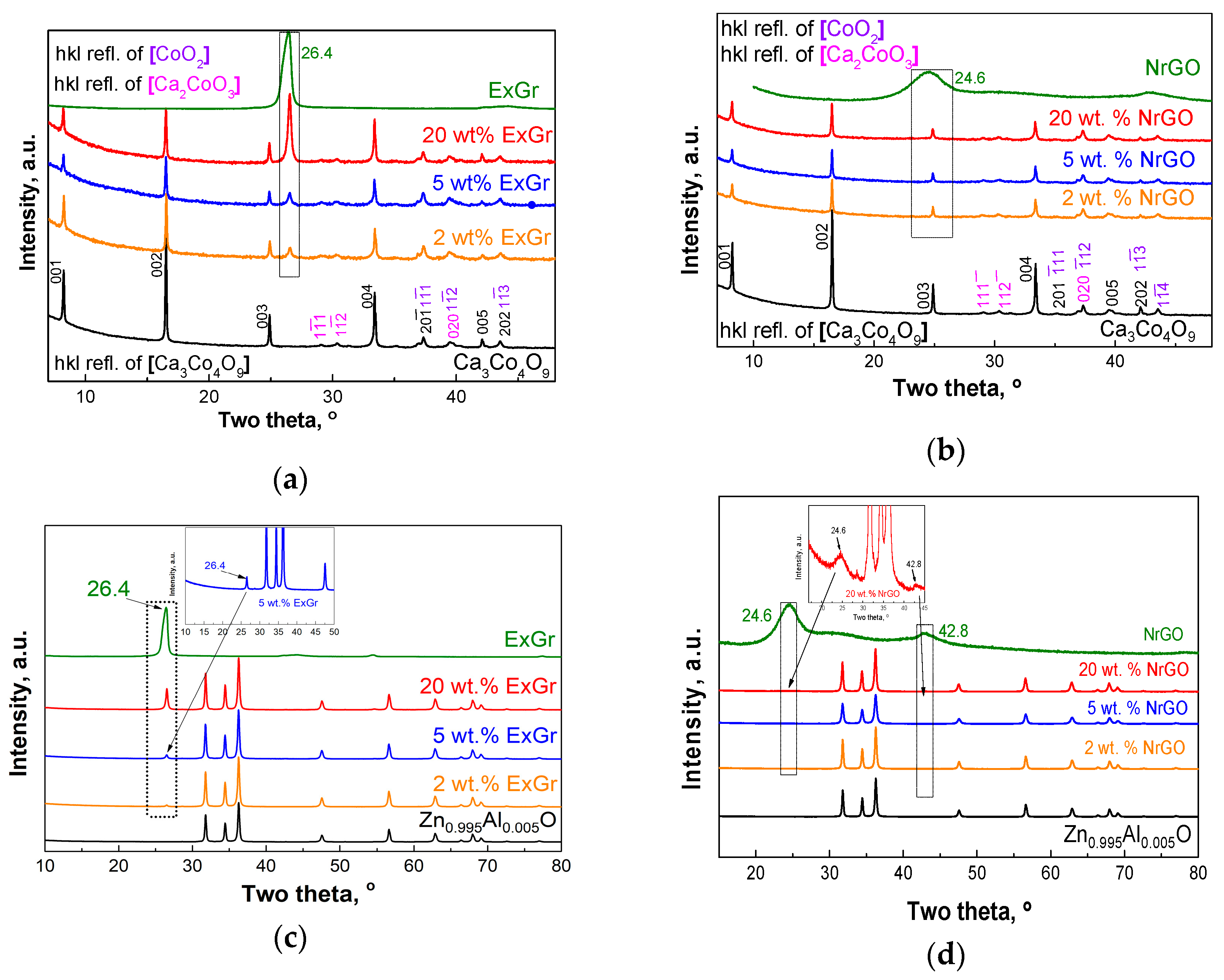


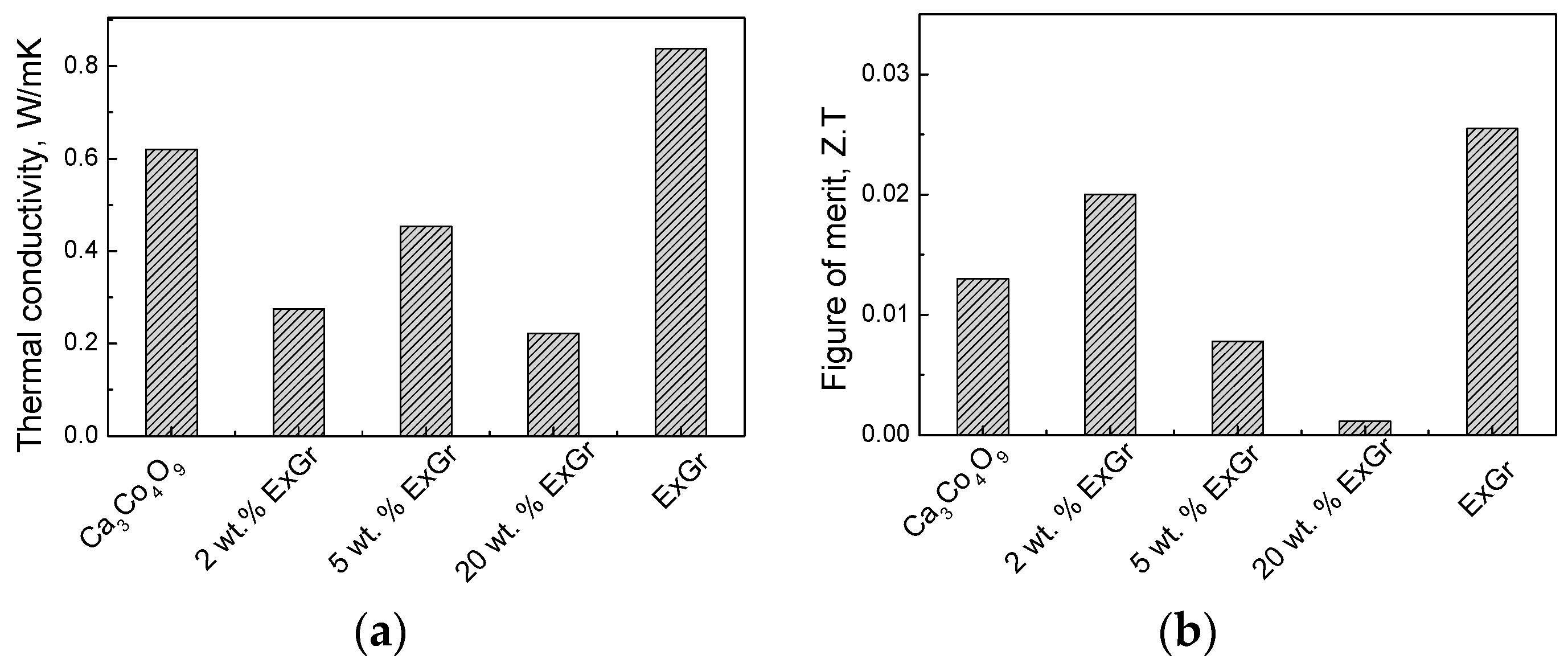





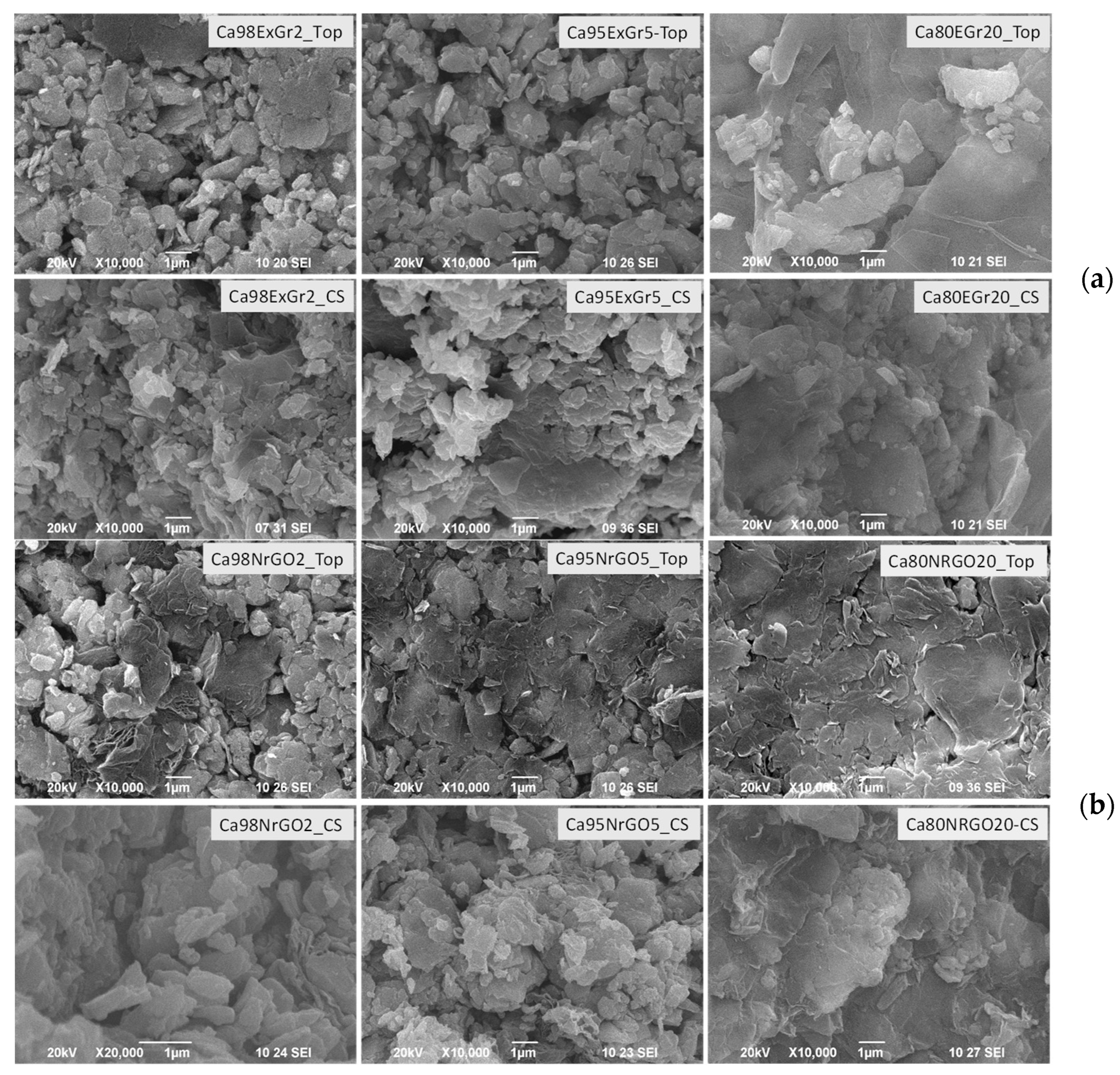

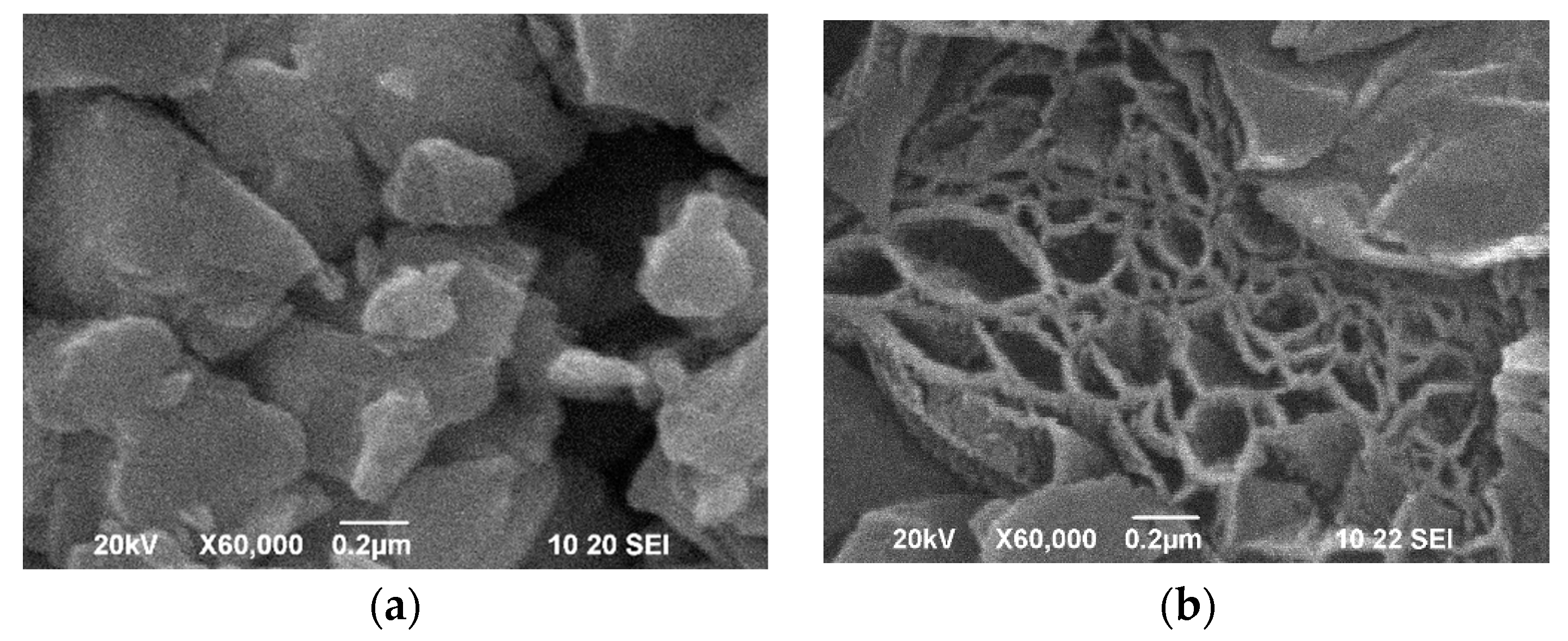

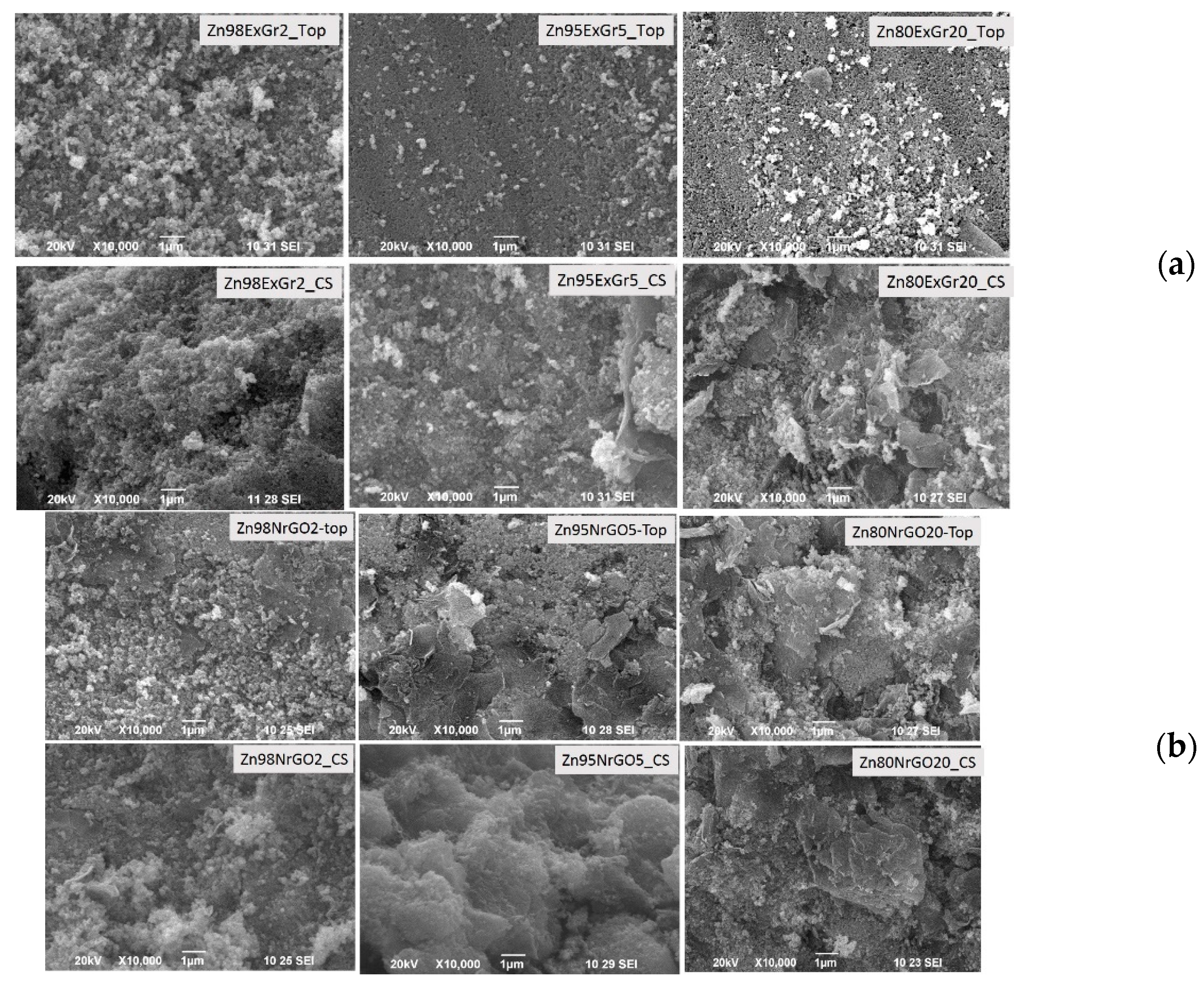
| Samples | ρ Ω.cm | S μV/K | PF = S2/ρ µW/(m·K2) | λ W/m.K | Figure of Merit S2T/(ρ·λ) |
|---|---|---|---|---|---|
| ExGr | 9.6 × 10−4 | −26.1 | 71 | 0.838 | 0.0255 |
| NrGO | 4.45 × 10−2 | −2.8 | 1.7 × 10−2 | 0.003 | 0.0017 |
| rGO | 7.98 × 10−2 | −0.6 | 3.9 × 10−4 | 0.005 | 2 × 10−5 |
| Ca3Co4O9 | 3 × 10−2 | 94 | 29 | 0.620 | 0.0130 |
| Zn0.995Al0.005O | 4.6 × 103 | −590 | 8 × 10−3 | 0.300 | 8 × 10−6 |
Disclaimer/Publisher’s Note: The statements, opinions and data contained in all publications are solely those of the individual author(s) and contributor(s) and not of MDPI and/or the editor(s). MDPI and/or the editor(s) disclaim responsibility for any injury to people or property resulting from any ideas, methods, instructions or products referred to in the content. |
© 2023 by the authors. Licensee MDPI, Basel, Switzerland. This article is an open access article distributed under the terms and conditions of the Creative Commons Attribution (CC BY) license (https://creativecommons.org/licenses/by/4.0/).
Share and Cite
Harizanova, S.; Vulchev, V.; Stoyanova, R. Graphene-Based Composites for Thermoelectric Applications at Room Temperature. Materials 2023, 16, 7262. https://doi.org/10.3390/ma16237262
Harizanova S, Vulchev V, Stoyanova R. Graphene-Based Composites for Thermoelectric Applications at Room Temperature. Materials. 2023; 16(23):7262. https://doi.org/10.3390/ma16237262
Chicago/Turabian StyleHarizanova, Sonya, Vassil Vulchev, and Radostina Stoyanova. 2023. "Graphene-Based Composites for Thermoelectric Applications at Room Temperature" Materials 16, no. 23: 7262. https://doi.org/10.3390/ma16237262





